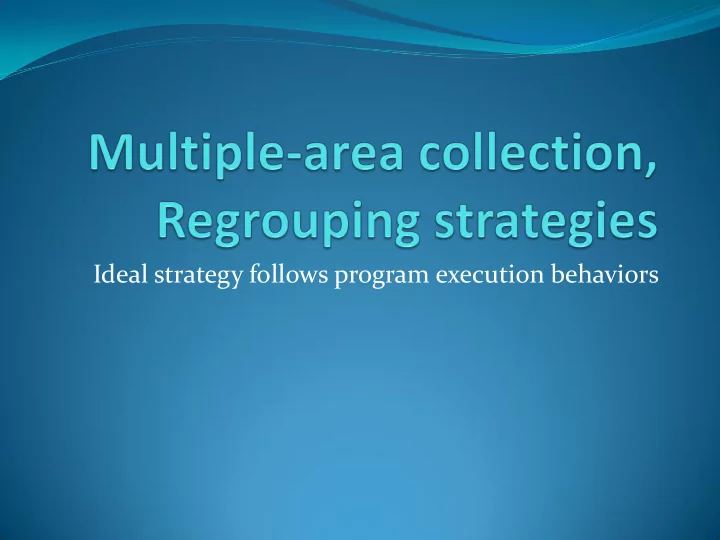

Ideal strategy follows program execution behaviors
Multiple-area collection Problem: CPU cost of scavenging depends in part on size of objects Copying small objects no more expensive than marking with bitmap Cost of copying large objects may be prohibitive Typically contains bitmaps and strings (atomic) Solution: Use large object space (separate memory region) Assume objects have header and body Keep header in semi-space Keep body in large object space (use mark-sweep) 2
Multiple-area collection Problem: Some objects may have some permanence Repeatedly copying such objects is wasteful Solution: Use separate static area Do not garbage collect such region Trace region for pointers to heap object outside static area Preview for generational garbage collection 3
Incrementally compacting collector Divide heap into multiple separately managed regions Allows compacting of parts of the heap Use mark-sweep or other approach on other regions Lang and Dupont: Divide heap into n + 1 equally sized segments At each GC cycle: Choose 2 regions for copying GC Mark-sweep other regions Rotate regions used for copying GC Collector chooses which transition to take next Give preference to mark-sweep to limit growth of stack 4
Effects of incremental compactor Compact small fragments into single piece Compactor will pass through every segment of the heap in n collection cycle Small cost: extra segment used for a semi-space 5
How efficient is Cheney’s alg.? Suppose: M size of each semi-space R number of reachable object s average size of each object Then: # objects allocated between GC cycles: = M/s – R If R = k, M/s – R = # objects reclaimed in each GC cycle 6
How efficient is Cheney’s alg.? Suppose: g CPU cost of GC per object reclaimed Then: c g M 1 sR g can be made arbitrary small by increasing M Increasing heap size reduces GC time See Jones and Lins, page 129 7
Garbage Collection locality issues Spatial locality: if a memory location is referenced at a particular time, then it is likely that its neighbors will be referenced in the near future Reasons for locality Predictability: one type of behavior in compute systems Program structure: related data stored in nearby locations. Easy to access next item Linear data structure: code contains loops that tend to reference arrays or other data structures by indices 8
Garbage Collection locality issues On virtual memory systems: Cost of page fault is expensive Tens of thousands or Millions of CPU cycles Additional CPU cycles to minimize page faults are worthwhile 9
Garbage Collection locality issues Two spatial locality issues relevant here MM system will touch every page in to-space MM allocator + garbage collector Increasing heap size increases number of pages touched Copying GC reorganizes the layout of objects in the heap Will impact spatial locality of heap data structures May compromise mutator’s working set 10
Increase heap size reduces GC time 11
Paging behavior: MSGC vs Copying Sophisticated MS Use stack or bitmap for mark-phase Mark phase does not touch/dirty heap pages Lazy sweeping does not affect paging behavior Linked into free list and will soon be reallocated Copying GC Next page to be allocated is likely the one LRU LRU is a virtual memory page replacement policy If set of pages in memory too small to hold both semi- spaces To-space pages evicted before used for allocation 12
Paging behavior: MSGC vs Copying Zorn compared paging behavior of collectors Conclusions: Virtual memory behavior of mark-sweep GC noticeably better than that of copying 13
Regrouping strategies Desire for relationship between data be reflected by their layout in heap More closely data are related the closer they should be placed in heap Relations may be Structural: objects are part of same data structure Temporal: objects accessed by mutator at similar times Placing related data on same page reduces page trafficking since bring data in memory also brings neighboring data 14
Regrouping strategies Objects typically created and destroyed in clusters Initial layout of objects in memory reflects future access patterns by user program Problem: Copying objects may rearrange their order or layout in the heap The way live objects are regrouped depends on the order that live graph is traversed. 15
Depth and breadth first copying 16
Regrouping strategies Can use regrouping strategies to improve locality Static regrouping Analyze topology of heap data at collection time. Move structurally related objects more closely Dynamic regrouping Cluster objects based on mutator access pattern Objects regrouped on-the-fly by incremental copying collector Depth first copying generally yields better locality than breadth-first copying 17
Copying vs Mark-sweep Method/Cost Mark-sweep Copying Initialisation clear mark-bits flip semi-space Cost negligible negligible Tracing mark objects copy objects Cost O(L) O(L) Sweeping lazily: transferred to allocation none Cost Allocation lazily: dominated by init done directly Cost O(M - R) O(M - R) L = volume live data in heap R = residency of user program M = heap size • Different constants of proportionality • Object size is important, especially for copying • Sophisticated copying collector easier to implement 18
Recommend
More recommend